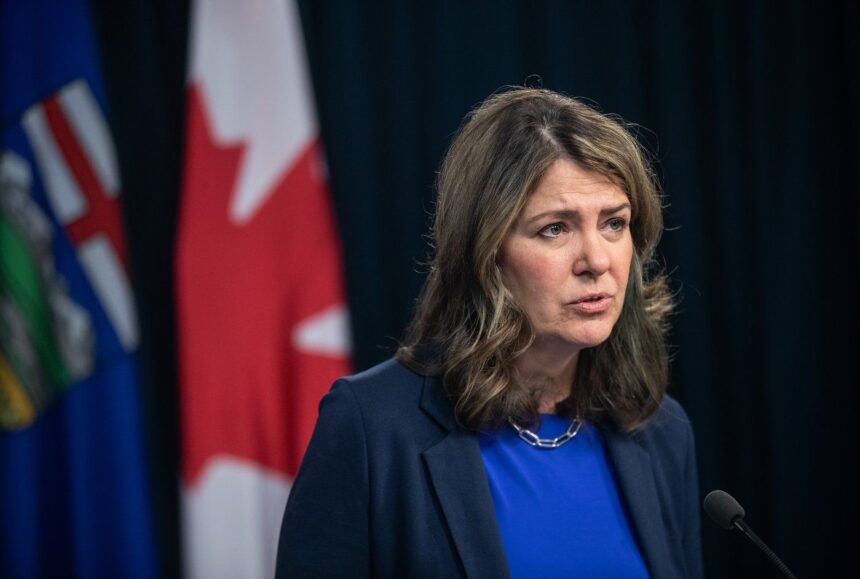A stone-cold silence swept across the community hall in Crowsnest Pass last night as Premier Danielle Smith faced down a room of more than 300 residents. Many had traveled hours through mountain roads to confront her about the province’s controversial new coal mining framework.
“My family has lived in these mountains for four generations,” said Ellen Marlow, a rancher who stood with microphone in hand, her voice steady but strained. “This isn’t just about today’s jobs. When that mine closes and the company leaves, who cleans up the selenium that will poison our watershed for decades?”
The Premier’s town hall, meant to ease tensions over Alberta’s newly announced “Resource Development Enhancement Plan,” instead revealed deep divisions between the UCP government’s economic vision and the concerns of rural communities across the province’s eastern slopes.
Smith defended the framework as “balanced” and “environmentally responsible,” but the crowd’s reaction suggested otherwise. Repeated interruptions forced moderators to call for order three times during the two-hour session.
“We’re creating approximately 1,200 jobs while maintaining stringent environmental protections,” Smith told attendees. “The eastern slopes can support both recreation and responsible resource development.”
According to government projections released last month, the coal policy changes could generate $420 million in provincial revenue over the next decade. However, documents obtained through Freedom of Information requests by environmental group Yellowstone to Yukon show that remediation costs for similar mining operations have historically exceeded initial government estimates by 200-300%.
The tension in Crowsnest Pass reflects broader provincial anxiety. A recent Angus Reid poll shows 68% of Albertans oppose expanded coal mining in the eastern slopes, with opposition crossing traditional political lines. Even in resource-dependent communities, support hovers at just 42% – hardly the mandate the government claims.
Dr. Fiona Henderson, hydrologist at the University of Calgary, who attended the meeting, pointed out that water quality concerns extend far beyond Alberta’s borders.
“The North Saskatchewan River watershed supplies drinking water to roughly 1.5 million people,” Henderson explained. “Selenium contamination from coal mining is incredibly difficult to remediate and persists for generations.”
When confronted with these concerns, Smith pointed to technological advances in mining practices. “This isn’t your grandfather’s coal industry,” she insisted, as several attendees shook their heads.
Jason Hale, a third-generation rancher from nearby Pincher Creek, wasn’t convinced. “I’m a conservative voter my whole life, but this isn’t conservation,” he told me after the meeting. “My cattle need clean water. My kids need clean water. Some things shouldn’t be for sale.”
The meeting grew particularly heated when Smith suggested that opposition was being fueled by “foreign-funded environmental groups” – a claim that drew audible groans from the audience.
“I’ve never taken a dime from anyone,” retorted Mary Stenson, a 72-year-old former schoolteacher who has lived in the area since childhood. “I just want my grandchildren to fish in the same streams I did as a girl.”
The controversy has created unusual political bedfellows. Conservative municipal leaders from six counties have joined with the NDP opposition and environmental organizations in calling for a return to the province’s 1976 Coal Policy, which had restricted mining in environmentally sensitive areas until it was rescinded in 2020.
NDP Leader Rachel Notley, speaking to reporters in Edmonton this morning, called the town hall “further evidence that Premier Smith is out of touch with Albertans’ values.”
“When both ranchers and environmentalists, urban dwellers and rural communities are all saying the same thing, perhaps it’s time for the government to listen,” Notley said.
The federal government may yet have a say. Environment Minister Steven Guilbeault stated last week that Ottawa is “watching the situation closely” and reviewing whether federal impact assessments might be required for proposed mining projects.
Coal mining in the region has a complicated history. The industry provided economic lifeblood for many communities throughout the 20th century, but left environmental scars that some areas are still working to heal. Modern mining techniques promise improved environmental outcomes, but many locals remain skeptical.
Walking out of the community hall, I spotted Smith speaking quietly with a small group of supporters, mostly representing local chambers of commerce and development associations. The majority of attendees, however, clustered in the parking lot, exchanging contact information and planning their next steps.
“This isn’t over,” said Tom Richards, a local outfitter whose business depends on the pristine mountains. “The Premier might think she can wait us out, but these mountains were here long before any of us, and we’re fighting for their future.”
As truck engines fired up and headlights illuminated the mountain mist, one thing became clear: in a province often divided along urban-rural lines, the coal policy has created new political fault lines that don’t fit neatly into traditional political categories.
For Premier Smith, who faces an election in less than two years, the path forward looks increasingly rocky – much like the beautiful eastern slopes at the heart of this growing controversy.






